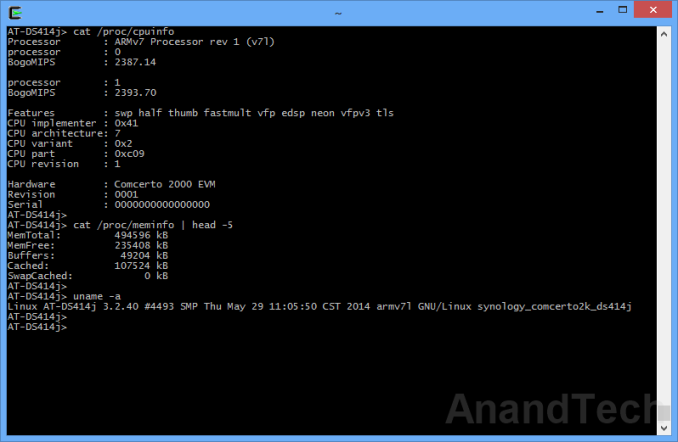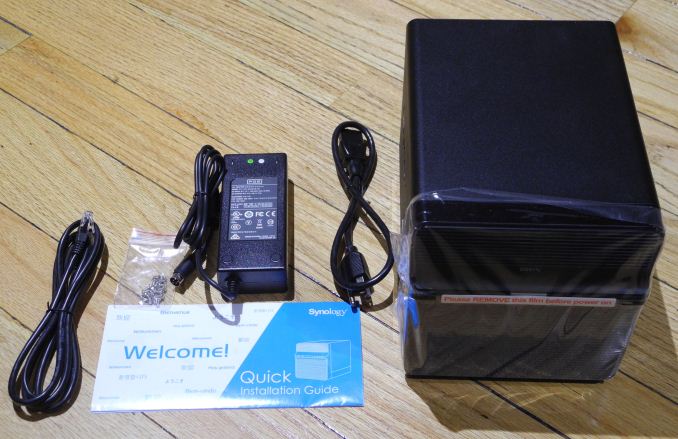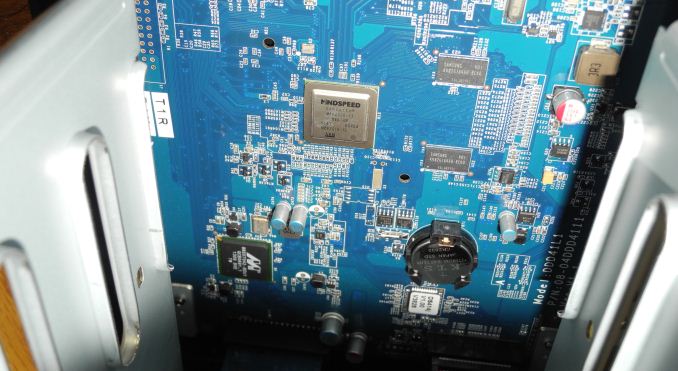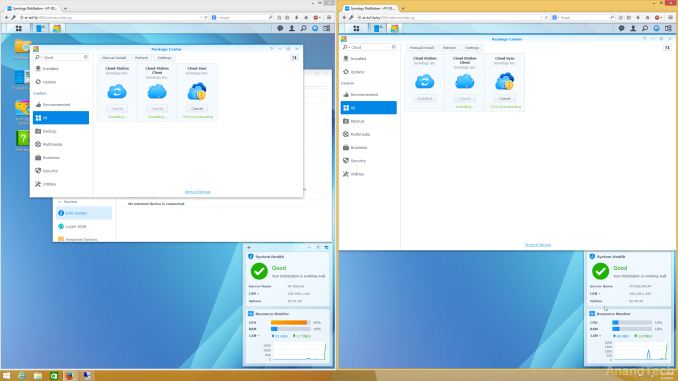
Original Link: https://www.anandtech.com/show/8244/synology-ds414j-an-ideal-backup-nas
Synology DS414j: An Ideal Backup NAS
by Ganesh T S on July 10, 2014 9:00 AM EST
Introduction
The consumer Network Attached Storage (NAS) market has seen tremendous growth over the past few years. As the amount of digital media generated by the average household increases, 4-bay solutions based on ARM platforms are turning out to be quite attractive for home users. Low cost and power efficiency are some of the positives for these types of solutions.
Synology targets the average home user market with the j-series models. These units have traditionally provided consumers with a very budget-friendly entry-level window into the DSM (Disk Station Manager) ecosystem. With drive capacities on the increase, we have seen people move to 4-bay NAS units in order to take advantage of RAID-10 (despite the loss of effective storage space). This helps to avoid (to a certain extent) risk-prone rebuilds associated with RAID-5 arrays. We have already evaluated solutions from Western Digital (WD EX4) and LenovoEMC (ix4-300d) in this space. In late April this year, Synology introduced the DS414j to provide consumers with an alternative in this market segment.
Western Digital and LenovoEMC's solutions are based on Marvell SoCs, but Synology bucks the trend by opting for a Mindspeed Comcerto C2200 dual-core communications processor in the DS414j. The SoC has two Cortex-A9 cores running at 1.2 GHz and plenty of hardware acceleration engines. The other specifications of the DS414j are provided in the table below.
| Synology DS414j Specifications | |
| Processor | Mindspeed Comcerto 2000 (2x Cortex-A9 @ 1.2 GHz) |
| RAM | 512 MB DDR3 RAM |
| Drive Bays | 4x 3.5"/2.5" SATA 6 Gbps HDD / SSD (No Hot-Swap) |
| Network Links | 1x 1 GbE |
| External I/O Peripherals | 1x USB 3.0 / 1x USB 2.0 |
| Expansion Slots | None |
| VGA / Display Out | None |
| Full Specifications Link | Synology DS414j Full Specifications |
| Price | $417 |
The DS414j runs Linux (kernel version 3.2.40). Other aspects of the platform can be gleaned by accessing the unit over SSH.
Testbed Setup and Testing Methodology
The Synology DS414j is a 4-bay unit. Users can opt for either JBOD, RAID 0, RAID 1, RAID 5, RAID 6 or RAID 10 configurations. We benchmarked the unit in RAID 5 with four Western Digital WD4000FYYZ RE drives as the test disks. Our testbed configuration is outlined below.
| AnandTech NAS Testbed Configuration | |
| Motherboard | Asus Z9PE-D8 WS Dual LGA2011 SSI-EEB |
| CPU | 2 x Intel Xeon E5-2630L |
| Coolers | 2 x Dynatron R17 |
| Memory | G.Skill RipjawsZ F3-12800CL10Q2-64GBZL (8x8GB) CAS 10-10-10-30 |
| OS Drive | OCZ Technology Vertex 4 128GB |
| Secondary Drive | OCZ Technology Vertex 4 128GB |
| Tertiary Drive | OCZ Z-Drive R4 CM88 (1.6TB PCIe SSD) |
| Other Drives | 12 x OCZ Technology Vertex 4 64GB (Offline in the Host OS) |
| Network Cards | 6 x Intel ESA I-340 Quad-GbE Port Network Adapter |
| Chassis | SilverStoneTek Raven RV03 |
| PSU | SilverStoneTek Strider Plus Gold Evoluion 850W |
| OS | Windows Server 2008 R2 |
| Network Switch | Netgear ProSafe GSM7352S-200 |
Thank You!
We thank the following companies for helping us out with our NAS testbed:
- Thanks to Intel for the Xeon E5-2630L CPUs and the ESA I-340 quad port network adapters
- Thanks to Asus for the Z9PE-D8 WS dual LGA 2011 workstation motherboard
- Thanks to Dynatron for the R17 coolers
- Thanks to G.Skill for the RipjawsZ 64GB DDR3 DRAM kit
- Thanks to OCZ Technology for the two 128GB Vertex 4 SSDs, twelve 64GB Vertex 4 SSDs and the OCZ Z-Drive R4 CM88
- Thanks to SilverStone for the Raven RV03 chassis and the 850W Strider Gold Evolution PSU
- Thanks to Netgear for the ProSafe GSM7352S-200 L3 48-port Gigabit Switch with 10 GbE capabilities.
- Thanks to Western Digital for the two WD RE hard drives (WD4000FYYZ) to use in the NAS under test.
Hardware Platform & Usage Impressions
The industrial design of almost all Synology NAS models strike the perfect balance between form and function. The hot-swap bays are easily accessible, the drive bay mechanism works great and the cooling system ensures adequate ventilation for the hard drives. Synology's j-series, however, doesn't support hot-swapping the disks in the specifications (mainly as a feature to cut down and a way to differentiate between the j- and the non-j models). In order to 'enforce' this, the disks had to be placed in a manner such that the user wouldn't accidentally remove / replace / hot-swap one of the disks. This is one of the primary reasons for the chassis design of the j-series being quite different.
The contents of the DS414j package are provided below:
- Synology DS414j chassis
- 2M Cat 5E Ethernet cable
- 90 W (12V @ 7.5A) external power supply with US power cord
- Getting Started guide
- Screws for hard disk installation
The main chassis looks like an antique box. While some tend to like the design, others prefer the simple and elegant traditional box with easily accessible drive bays on the front side. On the rear side of the unit, we have four screws which can be easily removed to bring down the hinged plate on which the fan is mounted. This exposes the motherboard at the bottom and the metal housing for the drives. Synology makes hot-swap virtually impossible by having mounting screws on the metal housing in addition to the screws for the plastic drive trays.
Platform Analysis
On the motherboard side of things, we can see the Mindspeed Comcerto 2000 SoC right in the middle with no heat sink. Towards the bottom left, we have a Marvell 88SX7042 SATA controller.
We already looked at the block diagram of the SoC in our launch piece on the 414j. The available high-speed I/Os include 2x SATA2, 2x PCIe 2, 1x USB 3.0 and 1x USB 2.0. Three GMACs are present, but the 414j uses only one of them for its sole RJ-45 port (with the help of a Realtek RTL8211E GbE PHY connecting through the RGMII interface). The Marvell 88SX7042 is present in almost all 4-bay NAS units of this generation and the DS414j is no exception. It is a 4x SATA II to 1x PCIe bridge that connects the drives in all the four bays to the SoC. The rest of the ports on the unit (1x USB 2.0 and 1x USB 3.0) come directly off the SoC.
Setup and Usage
After connection to the network, the unit obtains a DHCP address (even in diskless mode) and could be setup using the web UI at http://<DS414j-IP>. The determination of the IP itself could be done through Synology's helper site, find.synology.com. This service occasionally finds existing Synology units in the network too.
The setup process is straightforward. At least one of the bays needs to be populated. We chose to use the web interface (rather than the Synology Assistant tool) to initialize the NAS. The firmware (Synology Disk Station Manager - DSM) can be uploaded from a local file in this process. Basic administration settings are also configured. After a restart, the rest of the configuration is handled through the DSM web UI.
Upon logging into a freshly installed DSM, the user is provided with various options to aid in setup of external access to the NAS. Synology allows its users to create a MyDS account on their servers. The NAS units themselves are provided with a unique 'QuickConnect' ID. A MyDS account can have multiple QuickConnect IDs associated with it. The combination of this ID and a MyDS account helps Synology operate a relay service for access to the NAS from an external network. Users can opt to not register for these, but still enjoy external access if they forward the appropriate ports on their router.
The combination of a desktop-style interface and a multi-tasking UI with support for desktop widgets makes DSM a pleasure to use. Backing up the eye-candy is a rock-solid Linux-based storage management system and a wealth of applications (both Synology-created and third-party developed). Exploring all the features of DSM 5.x deserves a separate piece by itself. However, we will take a slightly different approach. In the DS214play review, we focused on the external access and multimedia features. In this, we will talk about the cloud / NAS backup and synchronization capabilities after discussing the benchmark results.
Our testing sequence started with the insertion of a single disk and configuring it in Synology Hybrid RAID (SHR). For a single disk, it is effectively a JBOD configuration, but the addition of a second disk triggers a migration to RAID-1. Even though the unit officially doesn't hot-swap, we were able to add and replace disks with the unit powered on. While migrating to the new RAID level on the DS414j, the data remained online and the process got done without any hitch. We tested RAID-5 rebuild by yanking out a disk during operation and re-inserting it (after externally formatting the drive). The rebuild process was also uneventful. On the whole, we were very satisfied with the unit's handling of storage operations (including handling of disk failures)
Single Client Performance - CIFS on Windows
The single client CIFS and iSCSI performance of the Synology DS414j was evaluated on the Windows platforms using Intel NASPT and our standard robocopy benchmark. This was run from one of the virtual machines in our NAS testbed. All data for the robocopy benchmark on the client side was put in a RAM disk (created using OSFMount) to ensure that the client's storage system shortcomings wouldn't affect the benchmark results. It must be noted that all the shares / iSCSI LUNs are created in a RAID-5 volume. The DS414j manages to compare favourably against (and actually beat in many cases) other ARM / Evansport-based 4-bay NAS units. Benchmark numbers are provided in the graphs below.
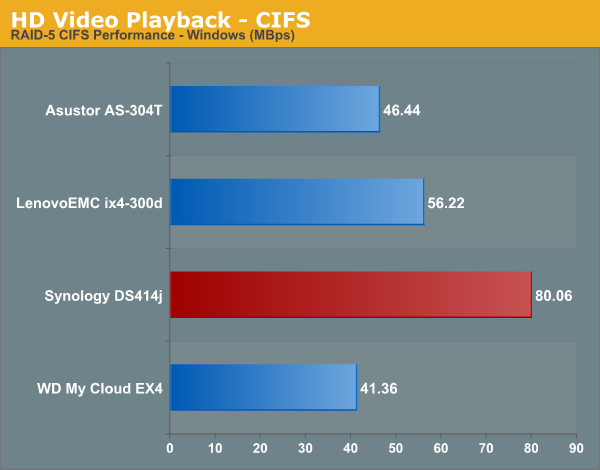
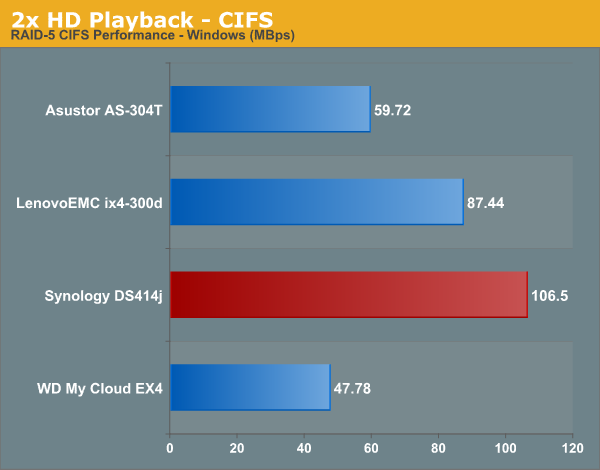
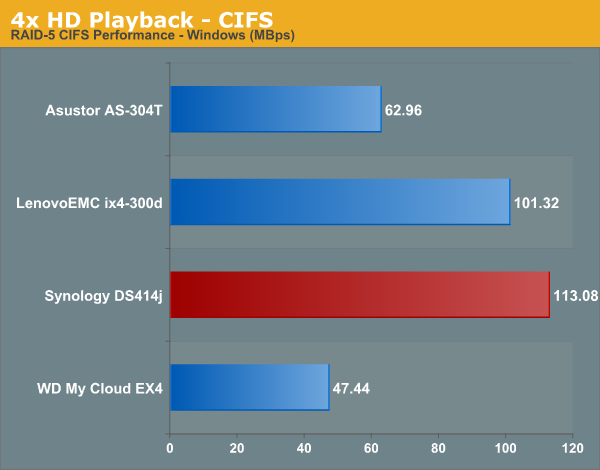

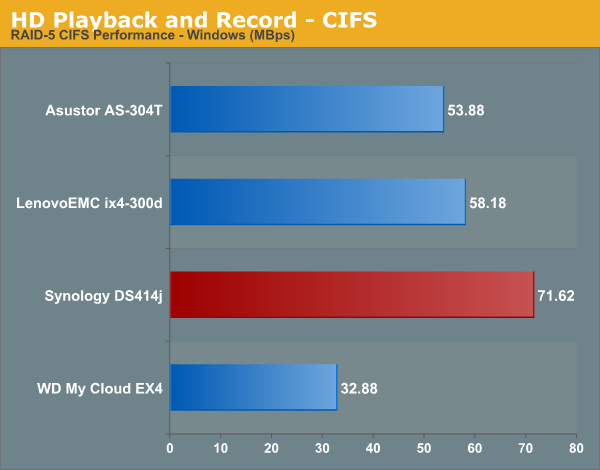
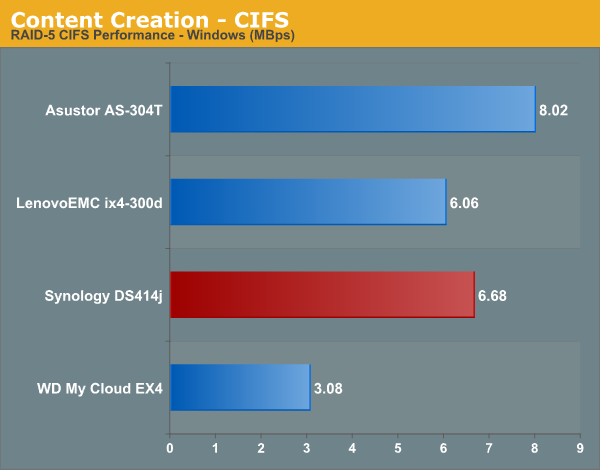
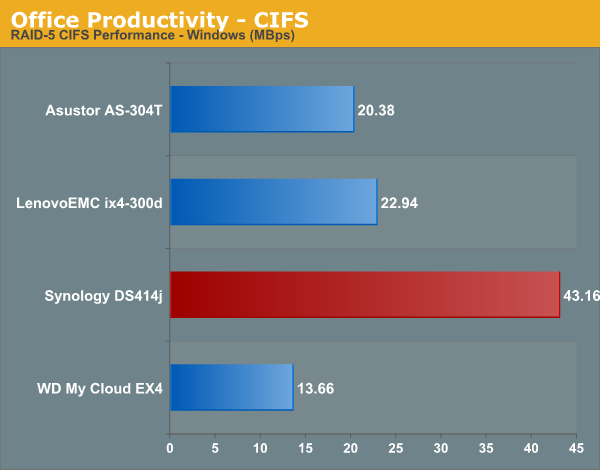
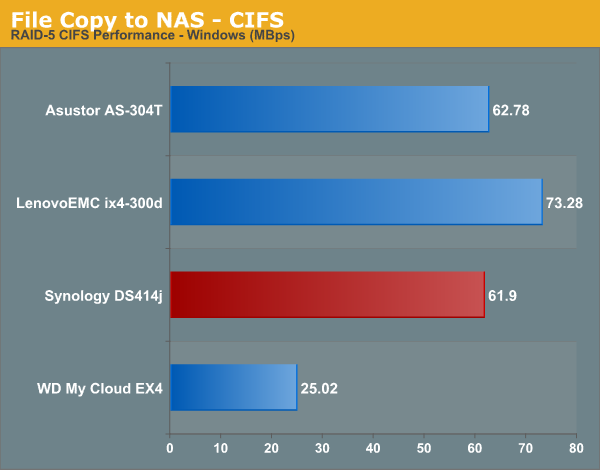

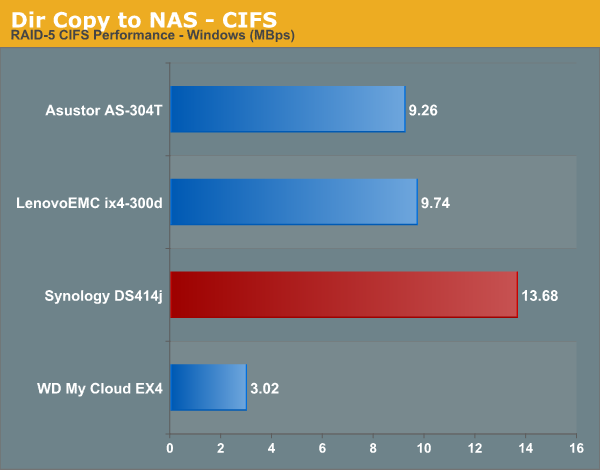
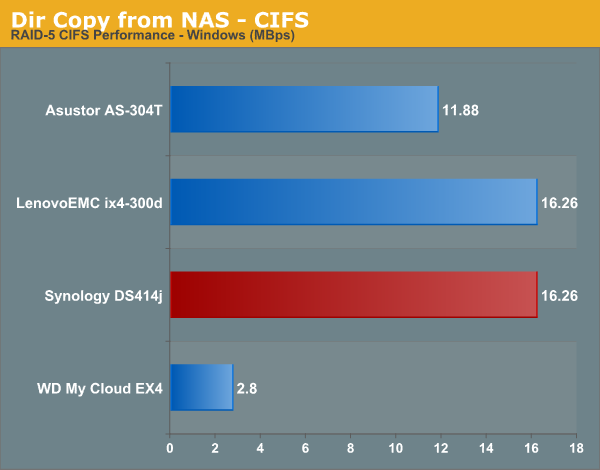
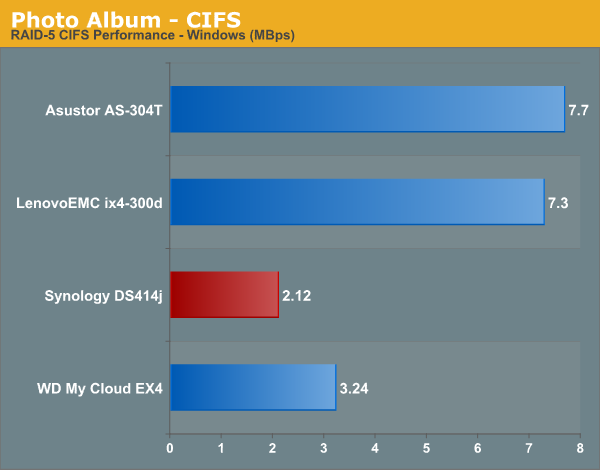
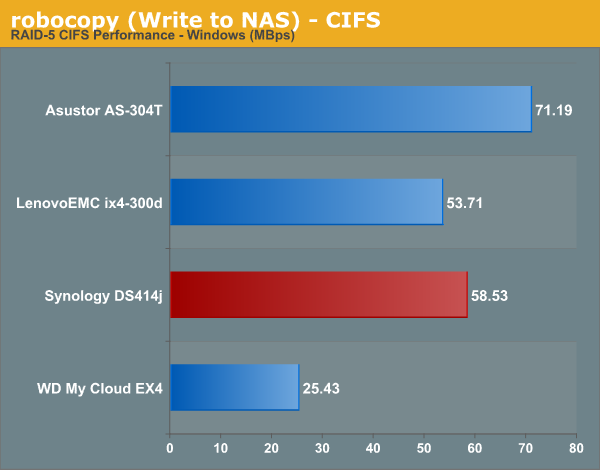
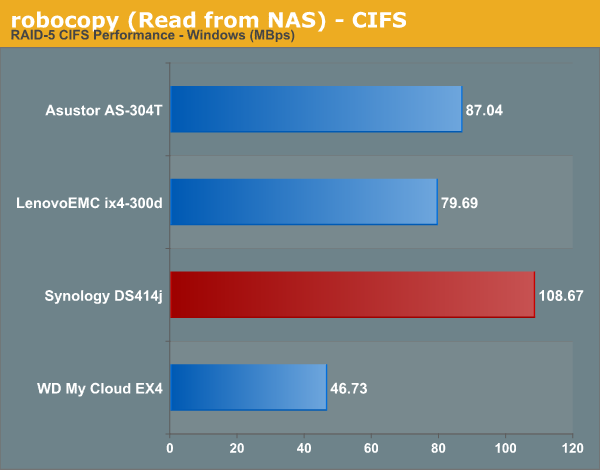
Encryption Support Evaluation
Consumers looking for encryption capabilities can opt to encrypt a iSCSI share with TrueCrypt or some in-built encryption mechanism in the client OS. However, if requirements dictate that the data must be shared across multiple users / computers, relying on encryption in the NAS is the best way to move forward. Most NAS vendors use the industry-standard 256-bit AES encryption algorithm. One approach is to encrypt only a particular shared folder while the other approach is to encrypt the full volume. Synology supports only folder-level encryption in DSM.
On the hardware side, encryption support can be in the form of specialized hardware blocks in the SoC (common in ARM / PowerPC based NAS units). In x86-based systems, accelerated encryption support is dependent on whether the AES-NI instruction is available on the host CPU. The Mindspeed SoC does have cryptography accelerator blocks. We enabled encryption on a a CIFS share to repeat our Intel NASPT / robocopy benchmarks. The results are presented in the graph below.
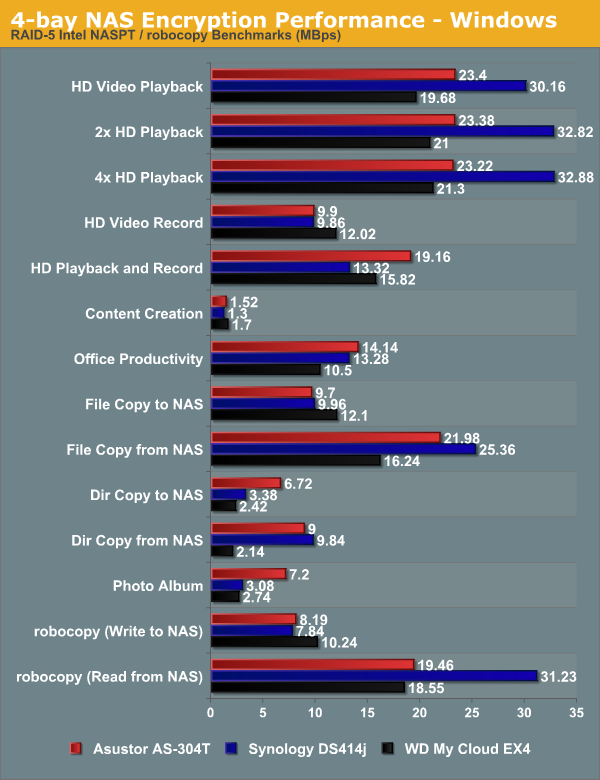
In this scenario, the write workloads suffer a bit compared to other NAS platforms. However, the read workloads are faster on the DS414j.
Single Client Performance - iSCSI On Windows
We created a 250 GB iSCSI target and mapped it on the Windows VM. The same benchmarks were run and the results are presented below. The observations we had in the CIFS section hold true here too.
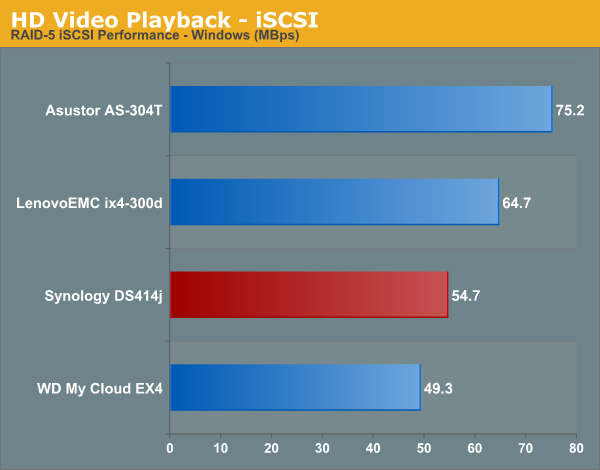
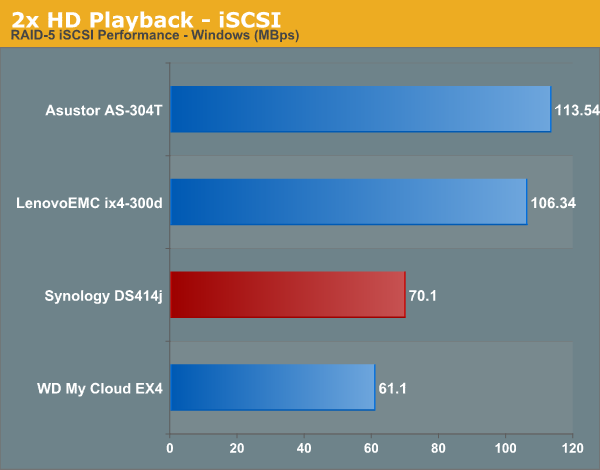

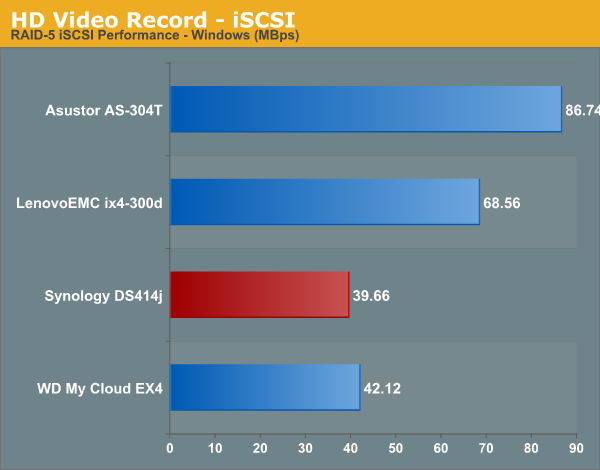
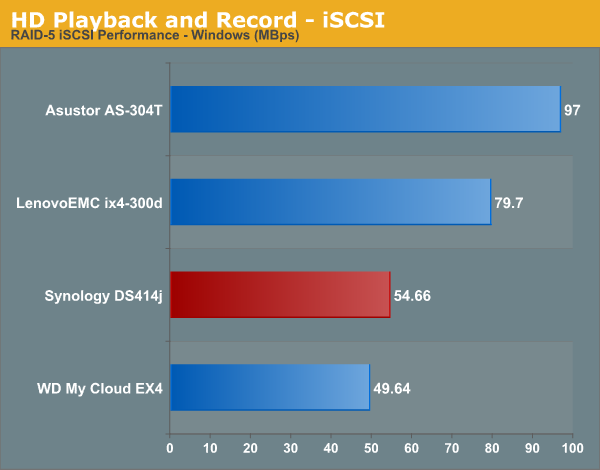
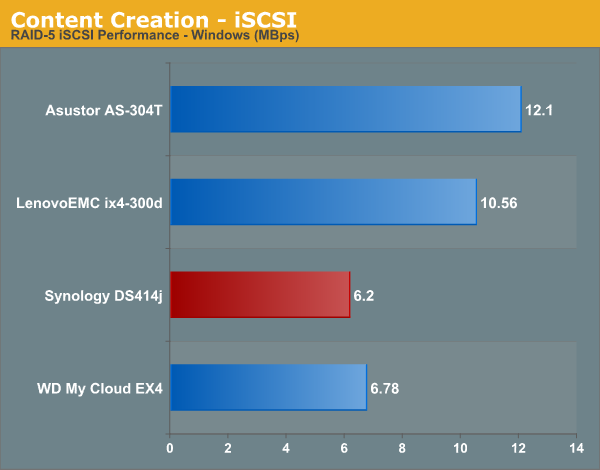
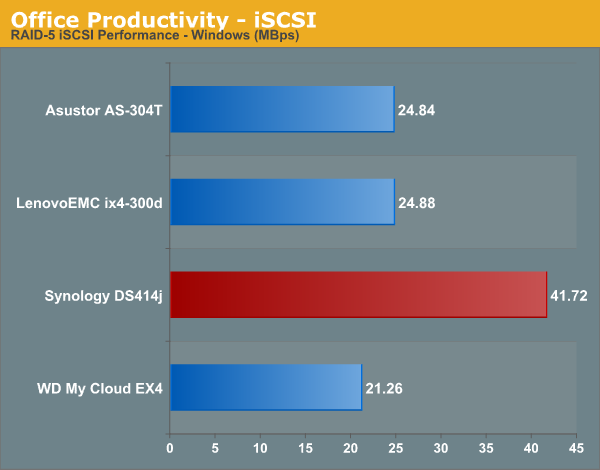
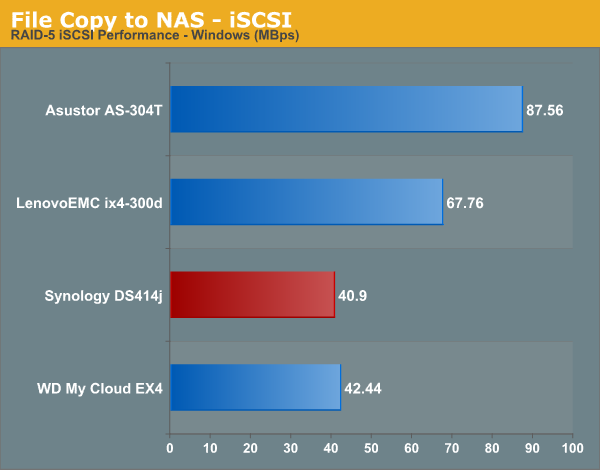
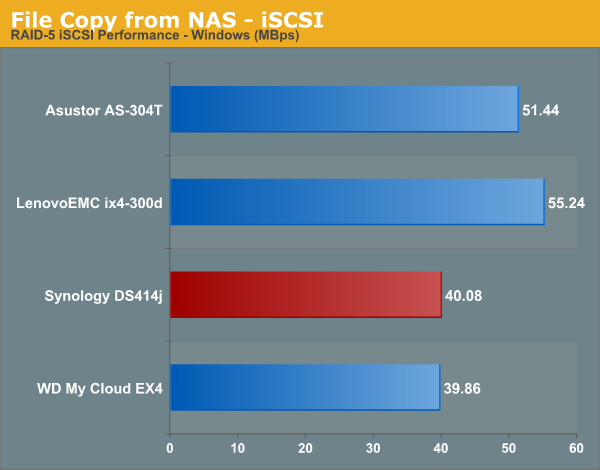
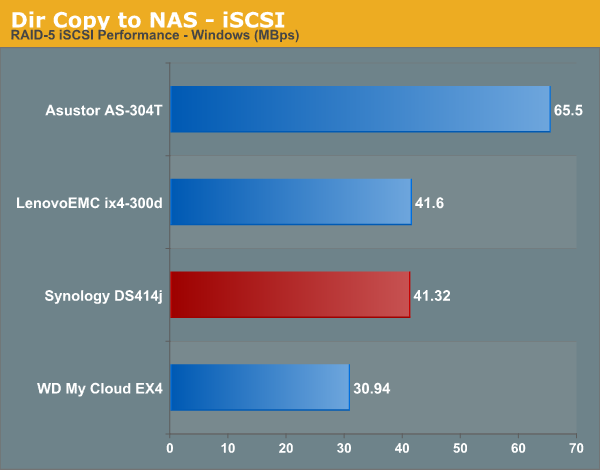
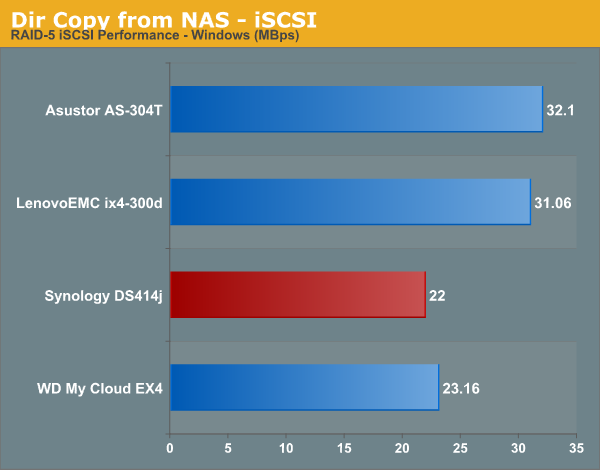
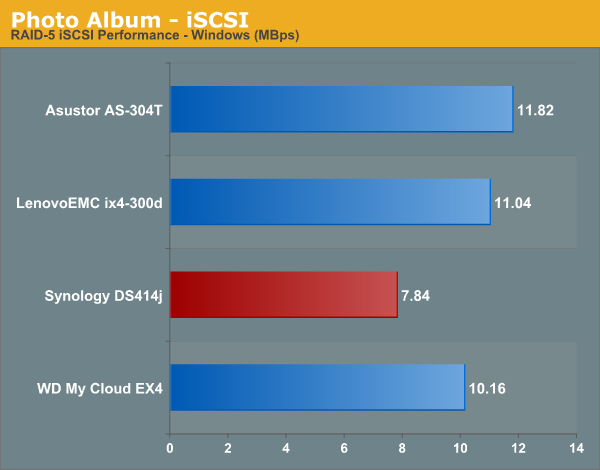

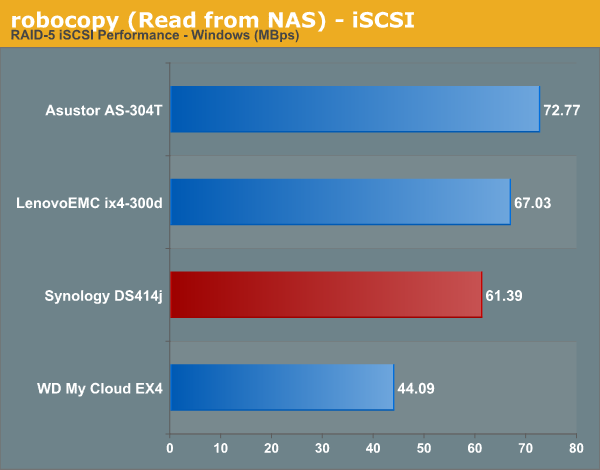
Single Client Performance - CIFS & NFS on Linux
A CentOS 6.2 virtual machine was used to evaluate NFS and CIFS performance of the NAS when accessed from a Linux client. We chose IOZone as the benchmark for this case. In order to standardize the testing across multiple NAS units, we mount the CIFS and NFS shares during startup with the following /etc/fstab entries.
//<NAS_IP>/PATH_TO_SMB_SHARE /PATH_TO_LOCAL_MOUNT_FOLDER cifs rw,username=guest,password= 0 0
<NAS_IP>:/PATH_TO_NFS_SHARE /PATH_TO_LOCAL_MOUNT_FOLDER nfs rw,relatime,vers=3,rsize=32768,wsize=32768,namlen=255,hard,proto=tcp,timeo=600,retrans=2, sec=sys,mountaddr <NAS_IP>,mountvers=3,mountproto=udp,local_lock=none,addr=<NAS_IP> 0 0
The following IOZone command was used to benchmark the CIFS share:
IOZone -aczR -g 2097152 -U /PATH_TO_LOCAL_CIFS_MOUNT -f /PATH_TO_LOCAL_CIFS_MOUNT/testfile -b <NAS_NAME>_CIFS_EXCEL_BIN.xls > <NAS_NAME>_CIFS_CSV.csv
IOZone provides benchmark numbers for a multitude of access scenarios with varying file sizes and record lengths. Some of these are very susceptible to caching effects on the client side. This is evident in some of the graphs in the gallery below.
Readers interested in the hard numbers can refer to the CSV program output here. These numbers will gain relevance as we benchmark more NAS units with similar configuration.
The NFS share was also benchmarked in a similar manner with the following command:
IOZone -aczR -g 2097152 -U /nfs_test_mount/ -f /nfs_test_mount/testfile -b <NAS_NAME>_NFS_EXCEL_BIN.xls > <NAS_NAME>_NFS_CSV.csv
The IOZone CSV output can be found here for those interested in the exact numbers.
A summary of the bandwidth numbers for various tests averaged across all file and record sizes is provided in the table below. As noted previously, some of these numbers are skewed by caching effects. A reference to the actual CSV outputs linked above make the entries affected by this effect obvious.
| Synology DS414j - Linux Client Performance (MBps) | ||
| IOZone Test | CIFS | NFS |
| Init Write | 57 | 34 |
| Re-Write | 56 | 36 |
| Read | 20 | 91 |
| Re-Read | 20 | 91 |
| Random Read | 11 | 34 |
| Random Write | 47 | 35 |
| Backward Read | 11 | 28 |
| Record Re-Write | 33 | 885* |
| Stride Read | 19 | 68 |
| File Write | 59 | 38 |
| File Re-Write | 56 | 37 |
| File Read | 14 | 64 |
| File Re-Read | 14 | 65 |
| *: Number skewed due to caching effect | ||
Multi-Client Performance - CIFS
We put the Synology DS414j through some IOMeter tests with a CIFS share being accessed from up to 25 VMs simultaneously. The following four graphs show the total available bandwidth and the average response time while being subject to different types of workloads through IOMeter. IOMeter also reports various other metrics of interest such as maximum response time, read and write IOPS, separate read and write bandwidth figures etc. Some of the interesting aspects from our IOMeter benchmarking run can be found here.
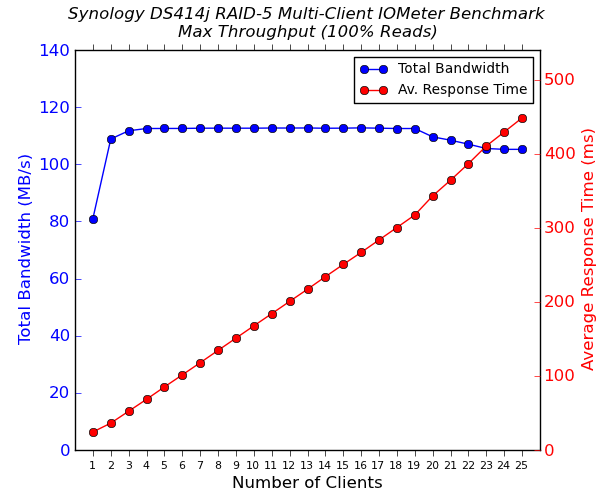
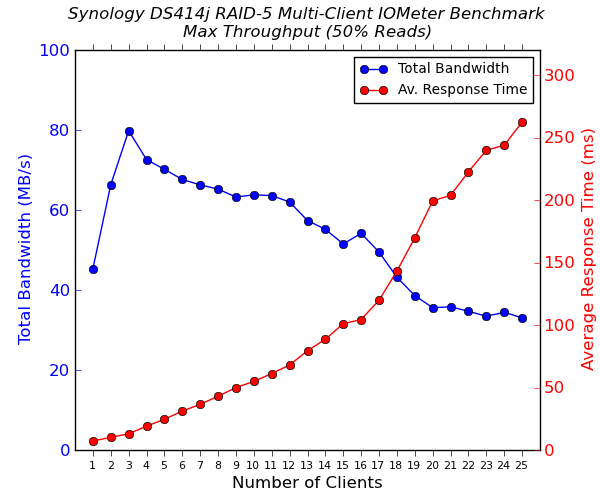
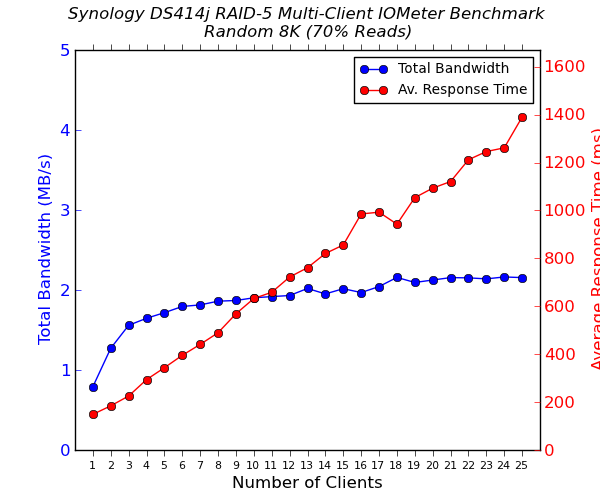
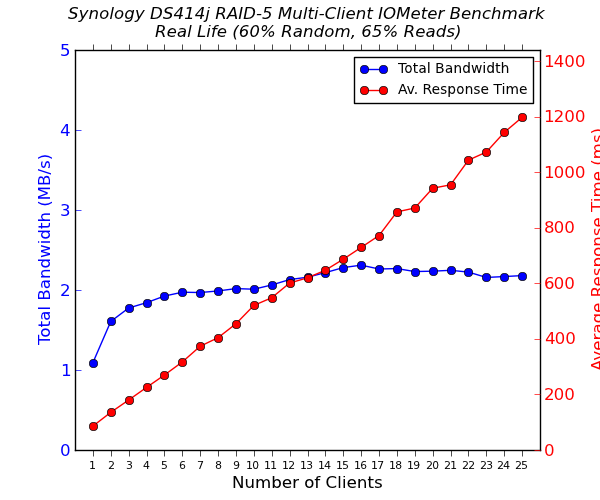
All the units compared with the DS414j in the above graphs come with two GbE links except for the Asustor AS-304T (which only has one). Compared to other units, we find that the Synology DS414j exhibits better consistency in performance as the number of simultaneous connections goes up.
DSM 5.0: Backup and Synchronization
Synology's sync and backup solution is comprised of three packages - Cloud Station, Cloud Station Client and Cloud Sync. In order to test out the capabilities / features, we decided to install the packages on two Synology NAS units - a DS214play and the DS414j unit under review.
In order to set up Cloud Station, the 'user home' service needs to be enabled first. After enabling Cloud Station, the mechanism becomes quite clear. The package allows syncing of files from computers (using a desktop program similar to Dropbox), mobile devices and other Synology NAS units. In order to enable a NAS unit to participate in the syncing process (i.e, contribute folders to), the Cloud Station Client package must be installed on it.
Users must also be explicitly enabled in the Cloud Station package in order to be able to set up the pre-existing folders for syncing (available under the Sharing option in Cloud Station). The package also allows users to see a list of clients connected to the NAS for syncing purposes. We also have versioning built into the package. The number of revisions to keep is configurable. From what I saw, the revisioning is not based on diff, but distinct copies are created for each version.
The Cloud Sync package allows users to back up / bidirectionally sync data with public cloud services such as Google Drive, Dropbox and Baidu Cloud. OneDrive and Google Photos are two important cloud services that are not yet part of the Cloud Sync package.
The Cloud Station Client package, as mentioned earlier, makes it easy to set up the local sync folder and the corresponding shared folder (that is configured on the other NAS).
Synology has great tutorials (for example, the one here) related to these packages on their site. Even though the packages and options may appear overwhelming at first, following the directions given in the tutorials makes it simple to set up a fully private cloud / syncing solution. Within a hour of setting up the packages, I had managed to make a copy of all the data that I had in the public cloud.
From Synology's perspective, potential areas of improvement include support for more cloud services in Cloud Sync, making available a wizard for configuring these packages and moving to a diff-based versioning system.
Miscellaneous Aspects & Concluding Remarks
The DS414j is a 4-bay NAS, and most users are going to use it in a RAID-5 configuration for optimal balance of redundancy and capacity. Hence, we performed all our expansion / rebuild testing as well as power consumption evaluation with the unit configured in RAID-5. The disks used for benchmarking (Western Digital WD4000FYYZ) were also used in this section. The table below presents the average power consumption of the unit as well as time taken for various RAID-related activities.
| Synology DS414j RAID Expansion and Rebuild / Power Consumption | ||||
| Activity | Duration | Avg. Power | ||
| Single Disk Init (4TB in JBOD) | 40m 9s | 19.53 W | ||
| 4 TB JBOD (1D) to 4 TB RAID-1 (2D) | 12h 57m 42s | 30.83 W | ||
| 4 TB RAID-1 (2D) to 8 TB RAID-5 (3D) | 56h 48m 29s | 39.43 W | ||
| 8 TB RAID-5 (3D) to 12 TB RAID-5 (4D) | 57h 14m 15s | 48.63 W | ||
| 12 TB RAID-5 Rebuild (4D) | 58h 56m 48s | 48.31 W | ||
Coming to the business end of the review, the DS414j comes across as a great way to get introduced to DSM while also ensuring that plenty of storage capacity is available. Performance is on par with other current ARM-based NAS platforms. Unlike other vendors, Synology doesn't hide away DSM features just because of the entry level pricing (I have seen other vendors avoid iSCSI in consumer units, for example).
Due to the absence of hot-swap capabilities officially, we would hesitate to recommend the DS414j as a primary NAS even for home users. However, its stellar performance (considering price class) and Synology's collection of apps for bidirectional synchronization with cloud services as well as other Synology NAS units make the DS414j an ideal backup candidate for SOHOs as well as the average consumer. Our only complaints are related to hot-swap being advertised as not available when the board and DSM actually support it and the convoluted chassis / drive cage design just for the sake of avoiding hot-swap. The RAID rebuild times are also the worst of all the 4-bay NAS units that we have evaluated so far..
Synology's 414j is targeted towards the same market segment that the Western Digital EX4 and the LenovoEMC ix4-300d currently serve. Performance is comparable and so are the feature sets (for example, DS414j and jx4-300d both don't support hot-swap). However, the DS414j is twice the cost of the ix4-300d. Synology's products carry a premium, and the pricing of the DS414j reflect that. Other than this pricing aspect and a few minor concerns voiced in the previous paragraph, the DS414j turns out to be a stable, reliable and feature-rich model.

